SoCal Rattlesnakes
As mentioned in the previous post, the goal of this trip is to get closer to having seen all the rattlesnakes of California. My progress is seen below:
| Species | Lifer Date | Encounters This Summer |
|---|---|---|
| Red Diamond Rattlesnake | March 29, 2018 | 2 |
| Northern Pacific Rattlesnake | June 4, 2018 | 3 |
| Southern Pacific Rattlesnake | March 27, 2019 | 0 |
| Colorado Desert Sidewinder | May 26, 2020 | 6 |
| Mohave Desert Sidewinder | July 1, 2020 | 4 |
| Panamint Rattlesnake | July 2, 2020 | 1 |
| Northern Mohave Rattlesnake | August 16, 2020 | 2 |
| Southwestern Speckled Rattlesnake | August 18, 2020 | 3 |
| Western Diamond-backed Rattlesnake | August 21, 2020 | 6 |
| Great Basin Rattlesnake | X | 0 |
This trip was a great success! I found all three of the remaining southern california rattlesnakes that I hadn’t seen. The only rattlesnake I have yet to see in California is the Great Basin Rattlesnake. Looks like I have a goal for next summer.
August 16
Escaping the thunderstorms in Northern California, I found myself entering the heatwave of Southern California. Having passed what was most likely a snake (too crowded of a road to stop and check) on the way in, I made sure to check some roads out after checking in. Within a couple moments of driving out of town I saw the familiar shape of a snake crossing the road. Unfortunately, in the time it took me to get the car off the road and get back to the snake another car and passed and hit it. First DOR Mohave Rattlesnake of the trip. A little dejected, I took it as a sign that the conditions were prime (and that this road had too much traffic). Not too much later, I was once again greeted by the sight of a snake crossing the road. This time we were able to get it off the road without issue.
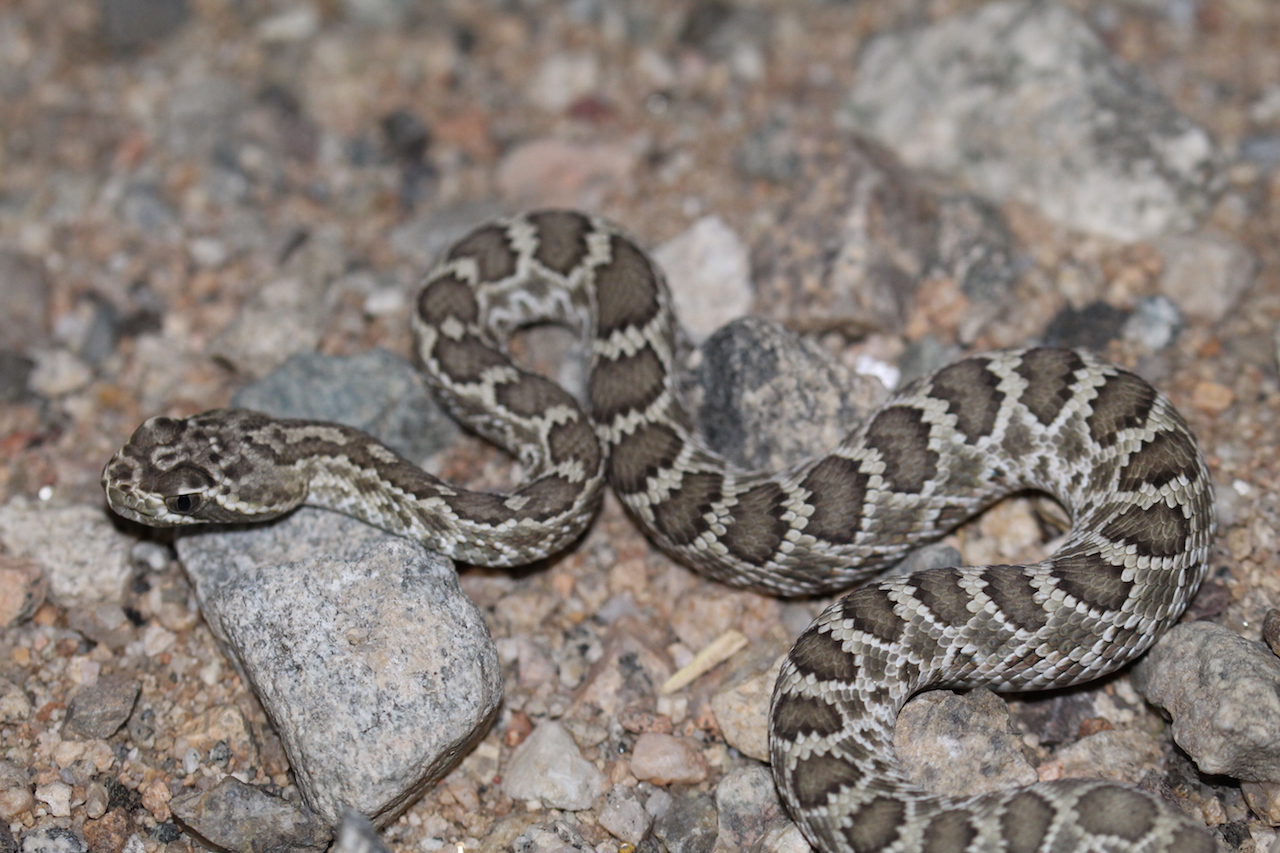
To my surprise it was another mohave rattlesnake! My lifer after having seen two DOR. I was excited, though still a little nervous considering I was still on the heavily trafficked road. The above photo is the only one I managed to get with the head in focus. The one below shows off its pattern and its single rattle or button. Truly a neonate snake.
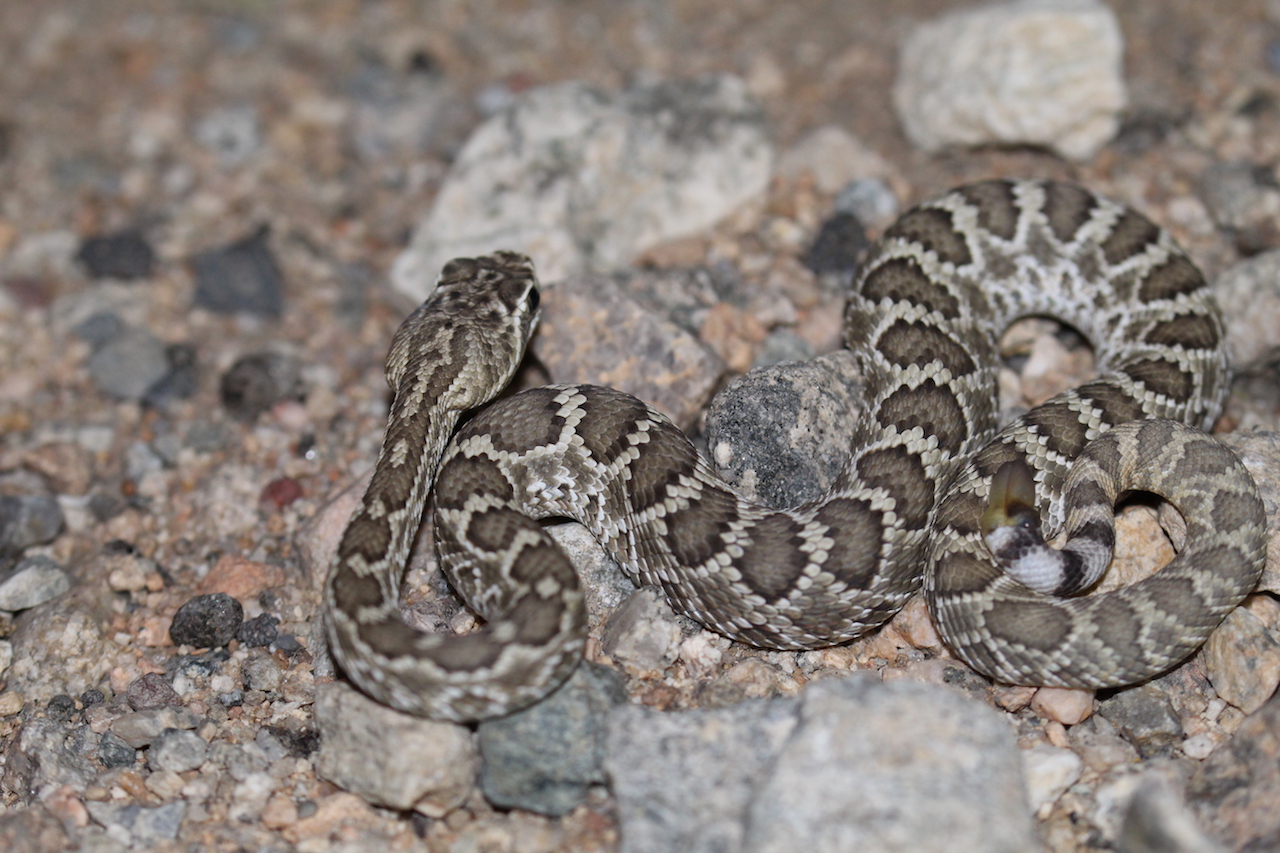
With a long trip ahead of me, I decided to call it after that luck and get some sleep.
August 17
On the second day, the luck continued. Before even arriving at Joshua Tree, I stumbled upon two snakes. The first, a california king snake, is always exciting and actually the first one seen in southern california this summer.
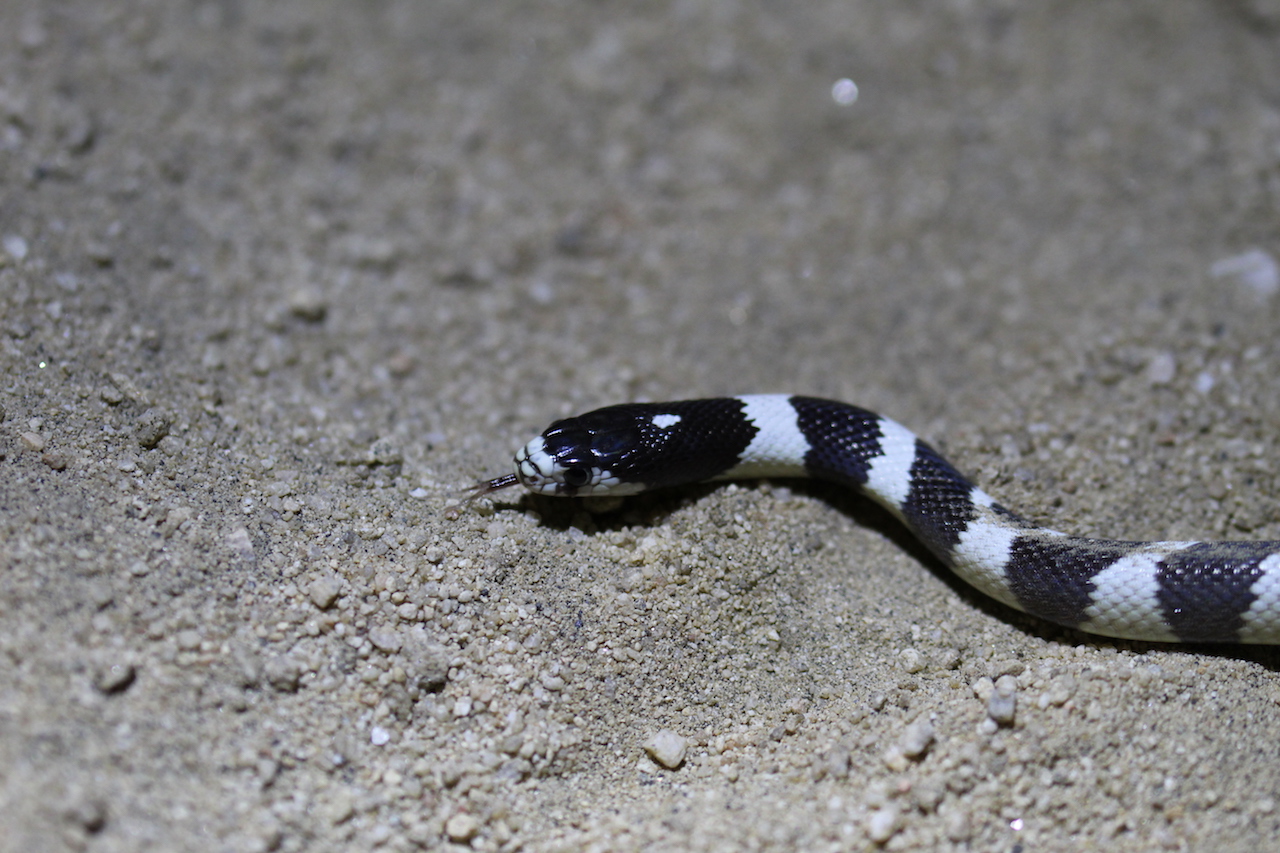
Since the next snake I found is my lifer long-nosed snake (spoiler!) I want to point out a couple characteristics of this kingsnake. First off, look at the back of the kingsnake’s head, there is the white tear drop. Second, look down the length of the kingsnake’s back. it’s white and black pattern is not uniform. Most black bands are diagnol and many do not go all the way across.
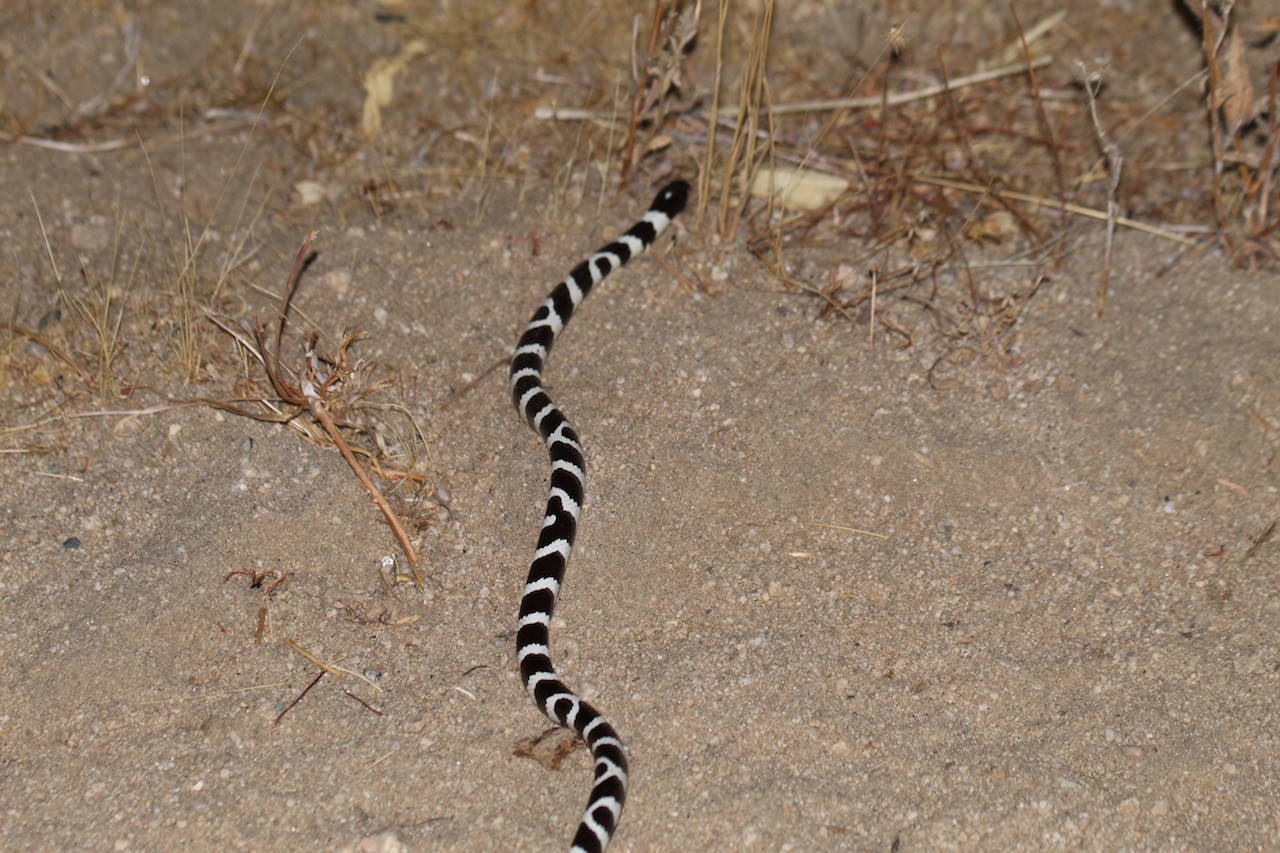
Here it is! My long awaited lifer long-nosed snake. I am aware of how common these guys are, but I have been looking forward to my first. I was surprised to see their range goes much higher north than I expected. Surprised I haven’t come across one before. Starting it off with a tight macro shot of its head.
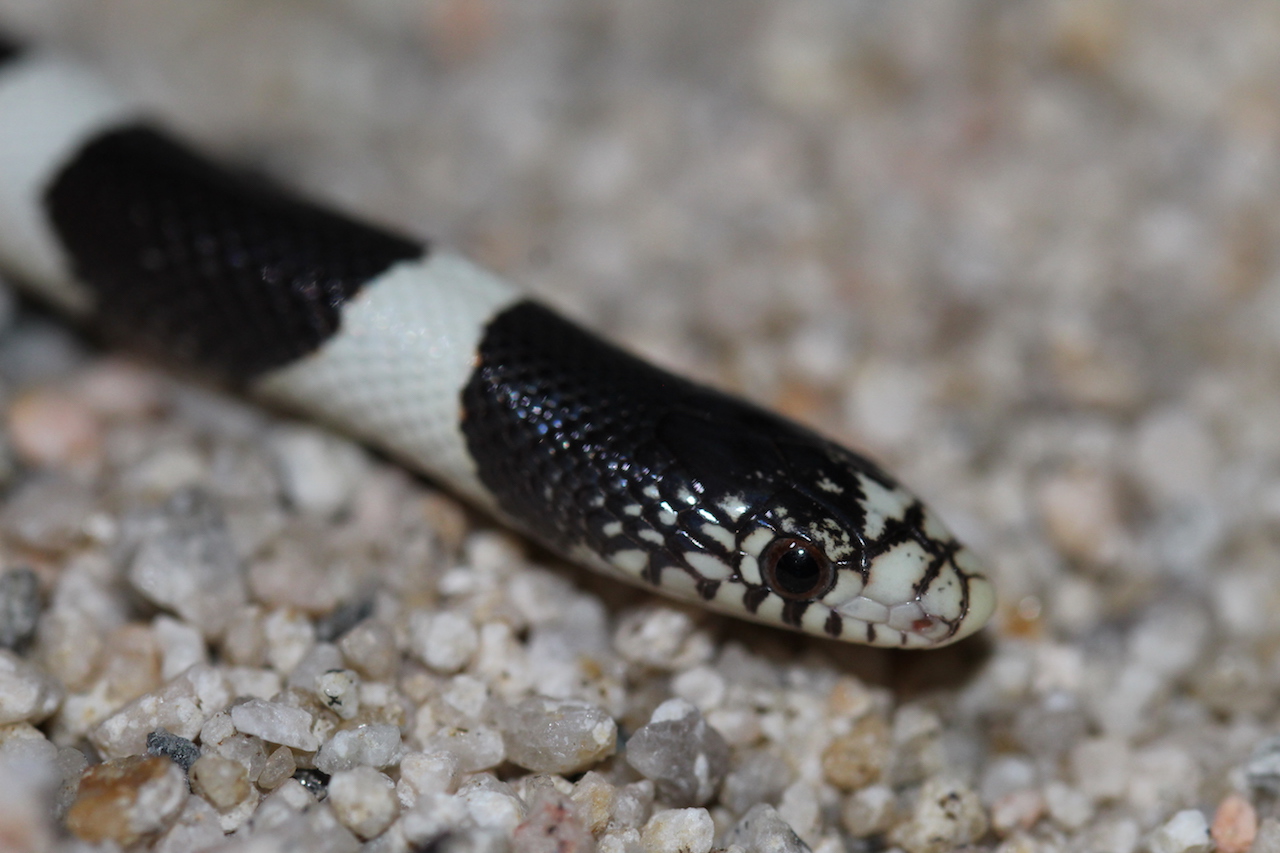
It appears to be a clarus phased long-nosed snake as there seems to be almost no reddish coloration. It wasn’t until looking back at these shots of the white blotches on the side that I was able to see the little red that is present. This guy was so active I was unable to see these with my naked eye.
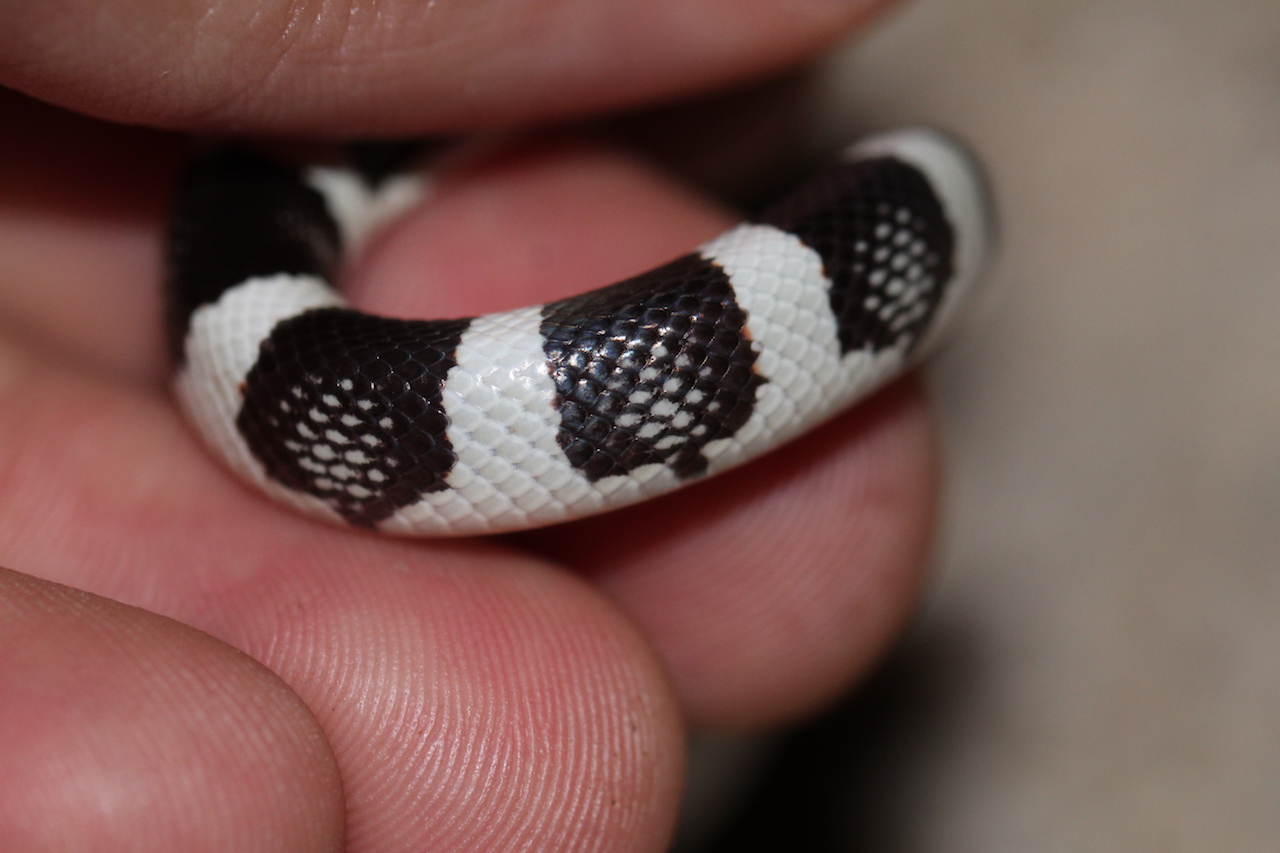
To continue the distinction with the kingsnake seen only ten minutes before, begin at the head by noticing its lack of tear drop. Second, notice the more uniform banding which goes directly perpendicular to the length of the snake (not diagnol). Lastly, the image above shows the white blotches in the black pattern and the slight red colors present (neither present in kingsnakes).
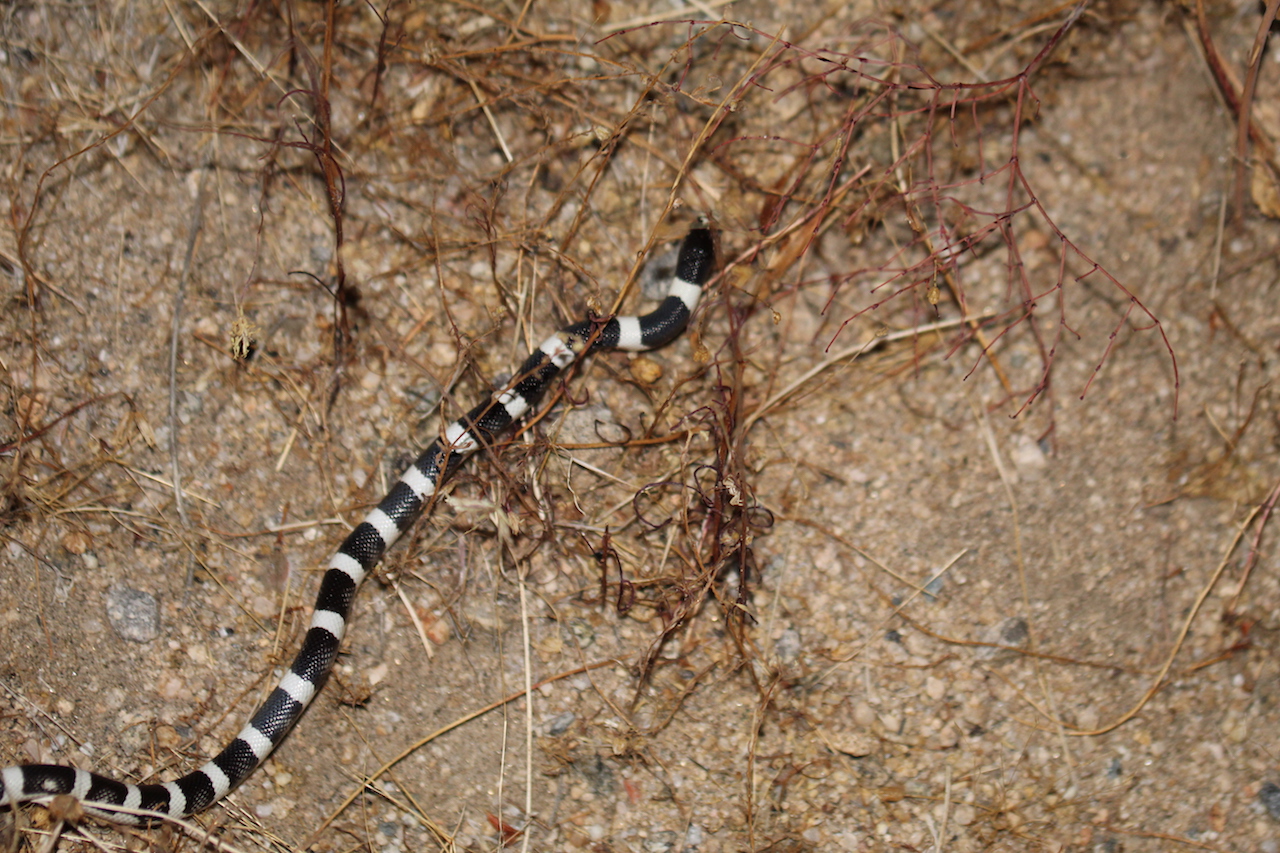
Now having finally made it into Joshua Tree, the next snake was unfortunately a quite dead mohave rattlesnake. Sticking with the trend, only about fifteen minutes beyond the DOR, a live one was found. I was excited at the opportunity to photograph another one, this one being a bit longer as well.
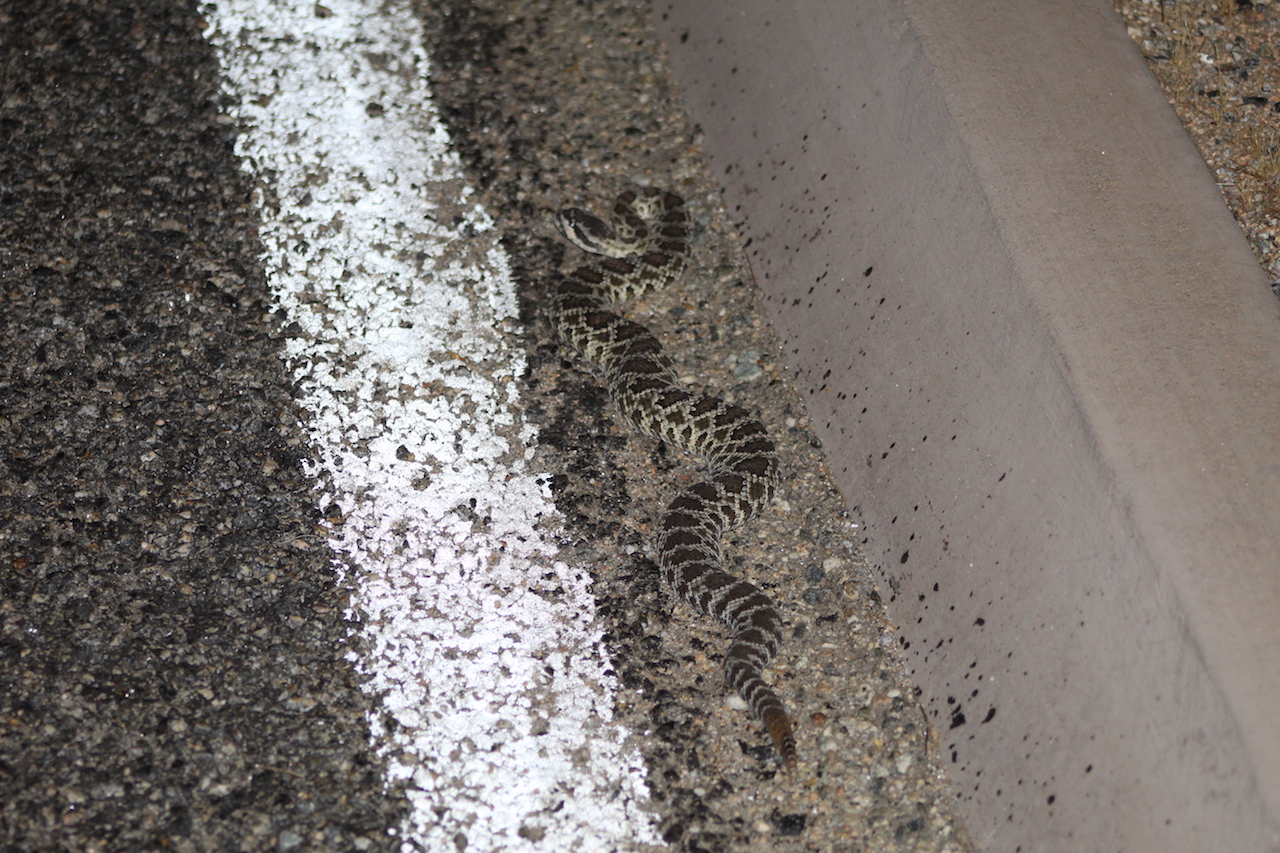
Crazy how well the pattern and color of the rattlesnake blended in with the road. Was really showing off its slight green colors and its rattle tail. I love how rattlesnakes seem to have that 45 degree head angle where they are just sensing.
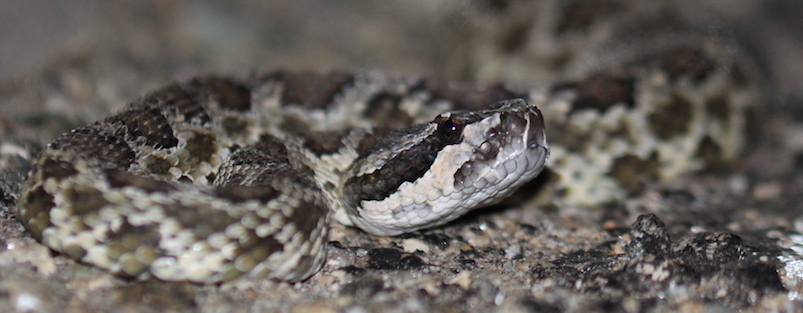

Need to work on my lighting in night shots, but I was happy with how those two headshots came out. I love getting tight headshots of rattlesnakes.
The last snake of the night was a Colorado Desert Sidewinder. Nice to see these guys again. This one was definetely a little larger than the ones I had seen before. About a 11 rattle tail hiding on the right side of the photo. This guy was alive with energy and quickly got off the road.
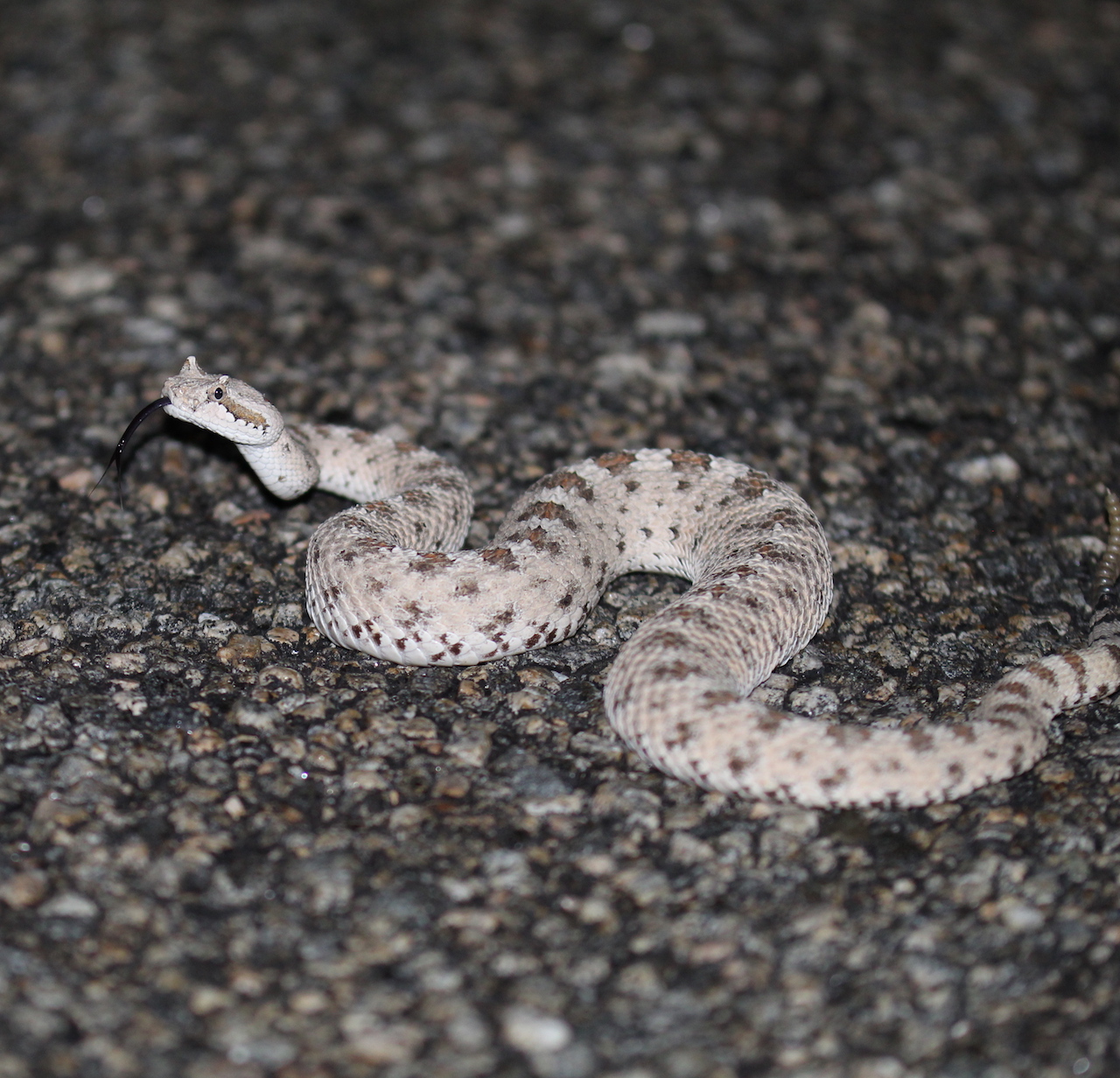
Aside from the heat lightning in the distantce, the only other excitement was encountering two DOR glossy snakes. I am sure more of those will be seen at some point during this trip.
August 18
Got out with a plan. First day looking for some Southwestern Speckled Rattlesnakes. Wanted to check out a couple locations and go for a little hike. Started out rather slow. The beginning roads were highly trafficked and the temperatures remained quite high. Hit one road that had no one on it, some high rocky hills on either side and looked quite promising aside from the triple digit temperatures. Kept moving and just like the night before, found the first snake right outside of Joshua Tree.
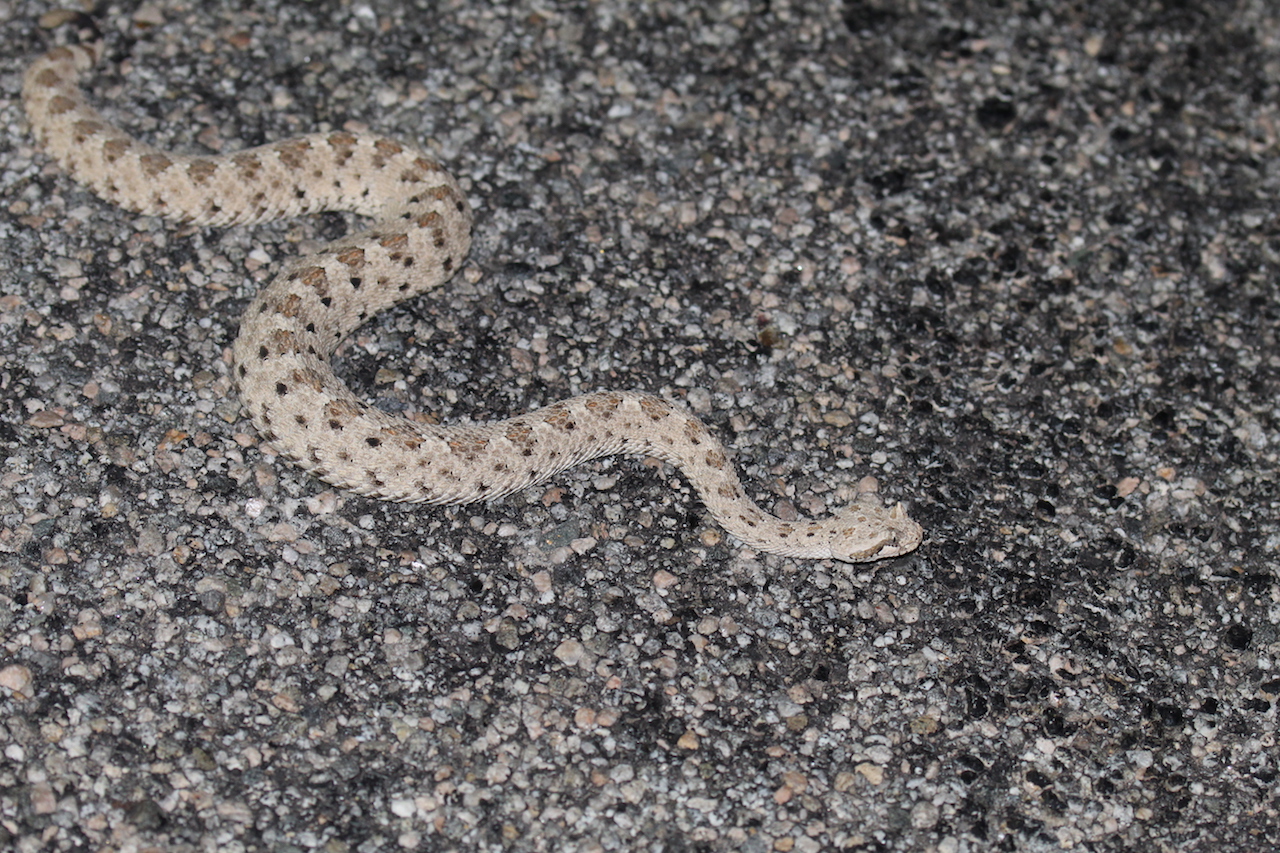
With no shoulder on the road and cars off in the distance, the snake was quickly moved off the road and the journey continued. Entering Joshua Tree, we scanned the horizon and looked for a good location to hike. Before much traveling we were off the road and walking through the desolate land. Dry and deserted at first look. Over time we began to notice life. We began to recognize the quick movements in the bushes were kangaroo mice, many of the lights reflecting back at us were small insects, and the holes we were stepping over were often occupied by Tarantulas.

It was a cool find to see the Tarantulas. Before long we began to notice them everywhere. Hanging out by their holes and being quick to retreat inside as we approached. They had a vaariety of colors ranging from light brown to dark brown with black stripes. Very neat!
We followed a wash up to the base of a rocky hill and began our slow scramble up. Carefully peering in every crack and crevice and watching our every step. In a matter of minutes I spotted our target. After stepping over a rock, I saw a small patch of dirt amongst the rocks with a creosote bush nearby. Caught off guard I rushed to pull out my camera and snap a couple shots.
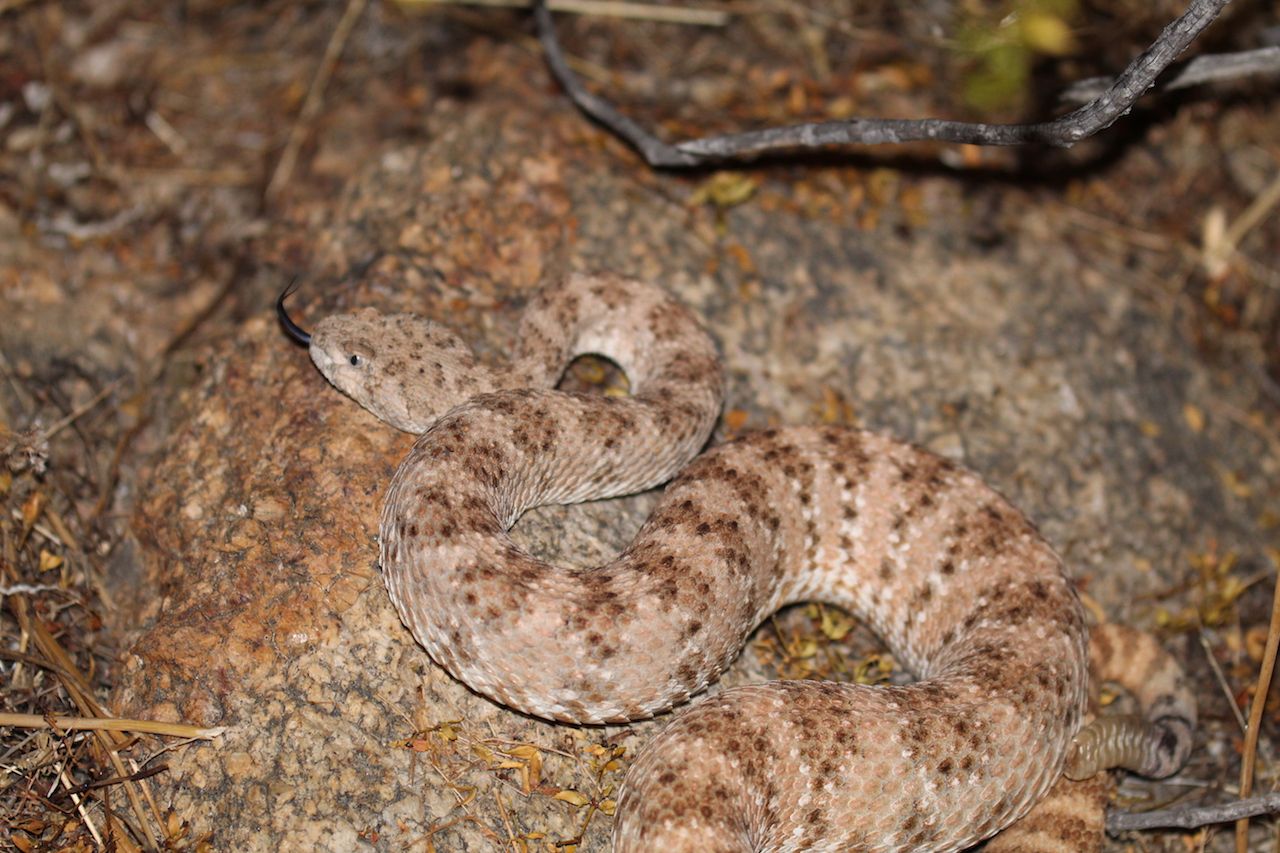
Very aware of my presence it retreated to the shelter of the creosote bush.
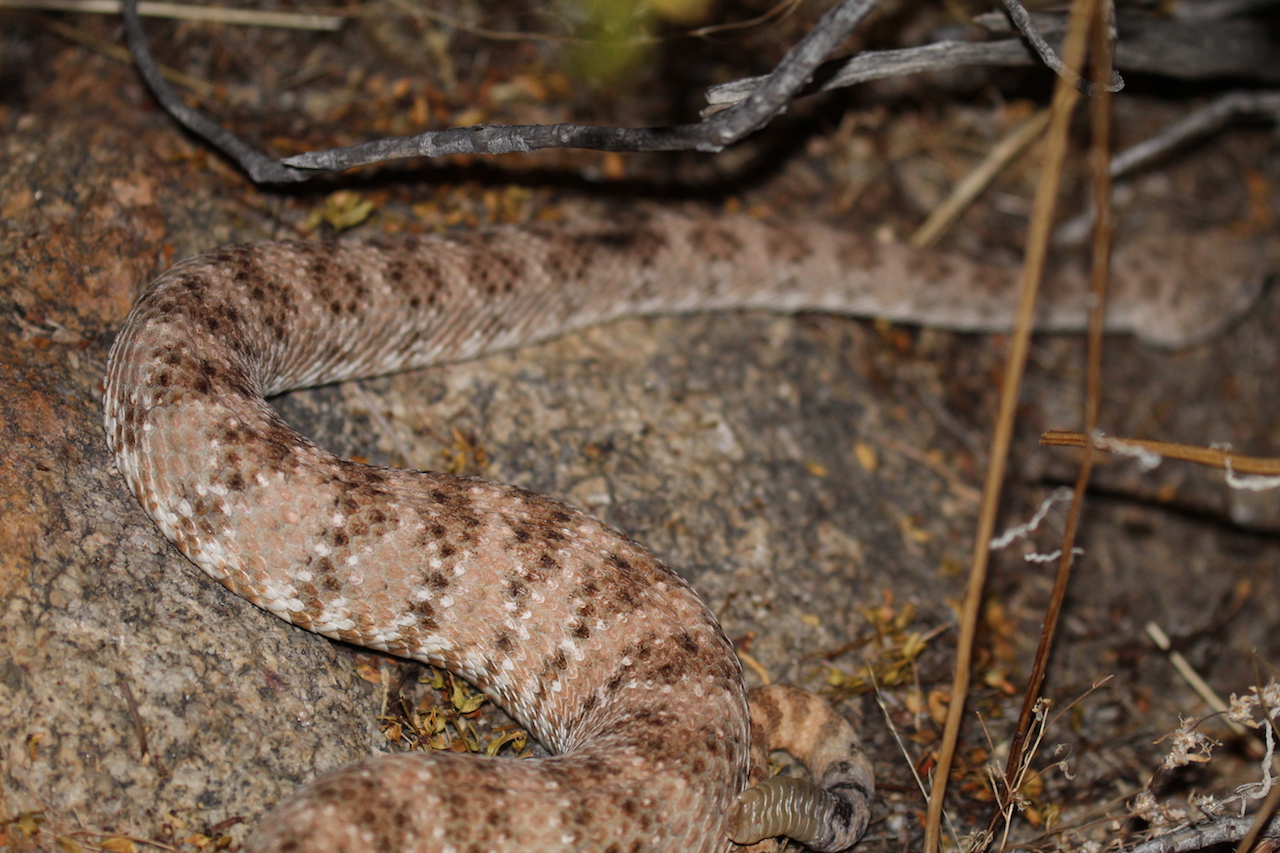
Coiled up, I got a couple shots before leaving it be.
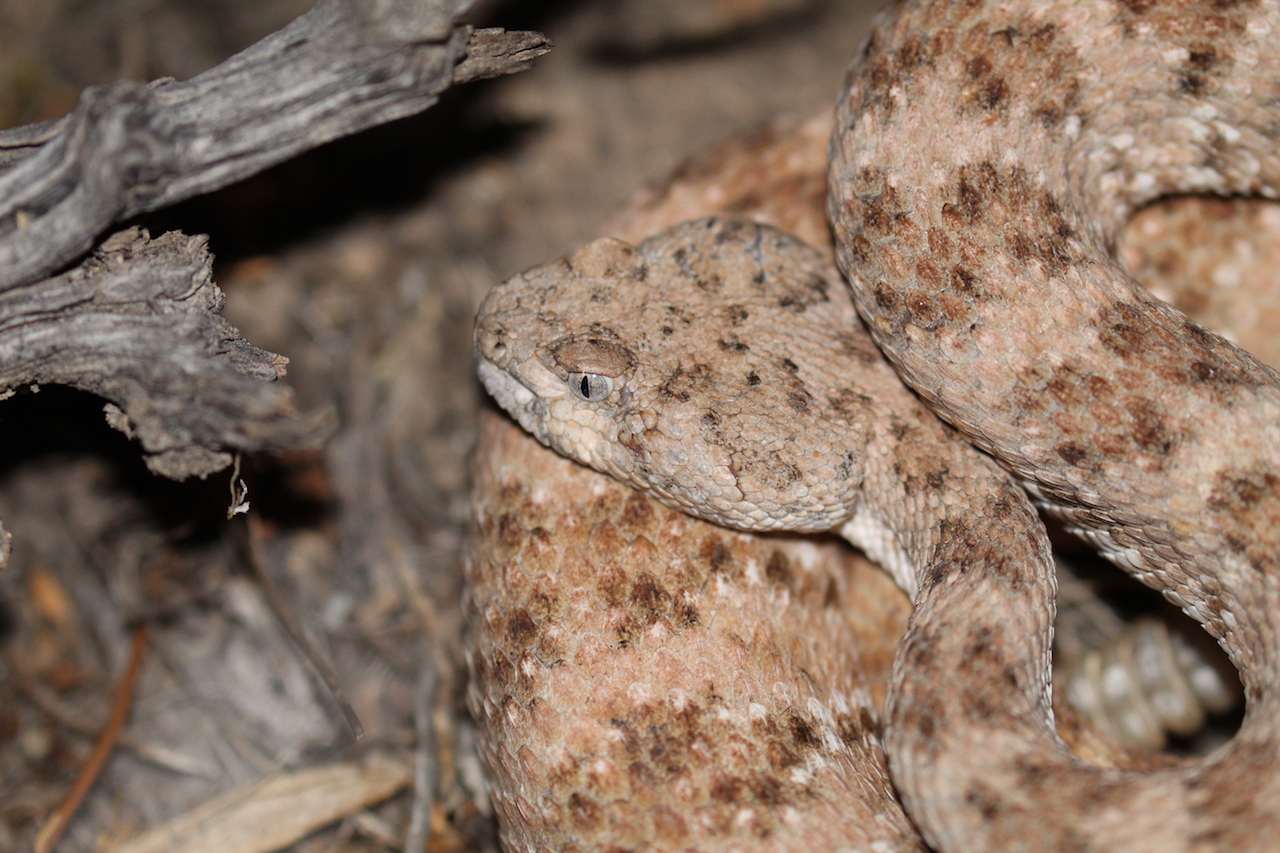
Crazy luck to find it so fast and have it be a larger one. Speckled rattlesnakes are known for having a variety of colors and patterns as their camoflouge represents the environment around them. This one was a peachy color which obviously represented its terrain. It is fascinating as the Colorado Desert Sidewinders in the area maintain a similar peachy color yet can be distinguished from speckled rattlesnakes by their “horned” eyes, smaller size, and unique locomotive method. On the topic of locomotives, I don’t know if it is a pattern of finding panamints and speckleds on the hunt but they seem to have a unique slither. It is almost an inching motion where they apply pressure with one segment of their body and inch the rest forward. Obviously, as my sample size is small I can’t comment on if it is situation dependent or species dependent.
On the journey back to the car, nothing was seen aside from some black widows. Content with the night after the successful hike, we began to head out of the park. A brief stop to look at the stars, enjoy the Perseid meteor shower, and watch bats circle the car. Passed a scorpion when we continued the drive, but was not fast enough to stop the car and find it.
About an hour into our drive back, we saw the familiar sight of a rattlesnake in the road. It did not take long to identify it as another speckled rattlesnake.
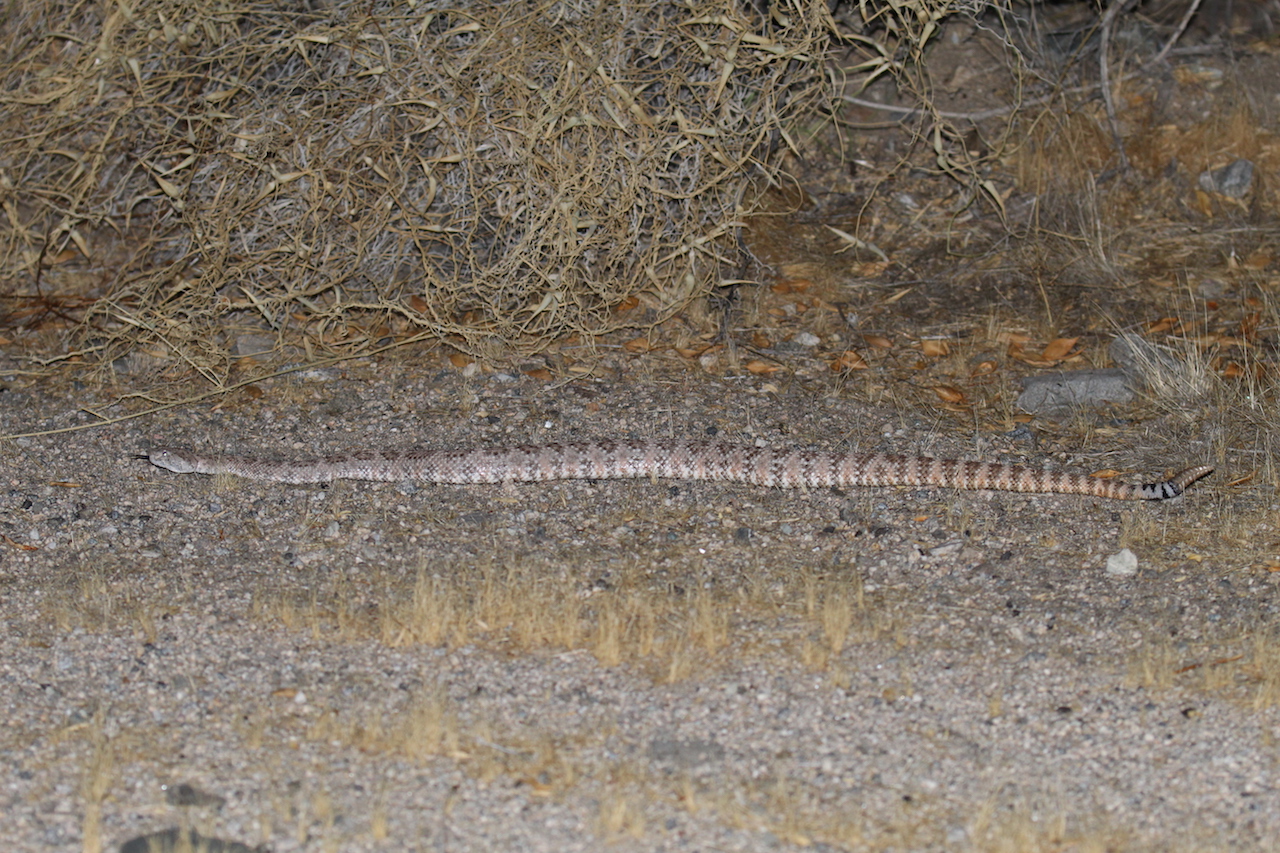
This one did not seem to bothered by our presence. Driving by it scared away a couple mice and I am sure the rattlesnake was annoyed with our presence scaring away its prey.
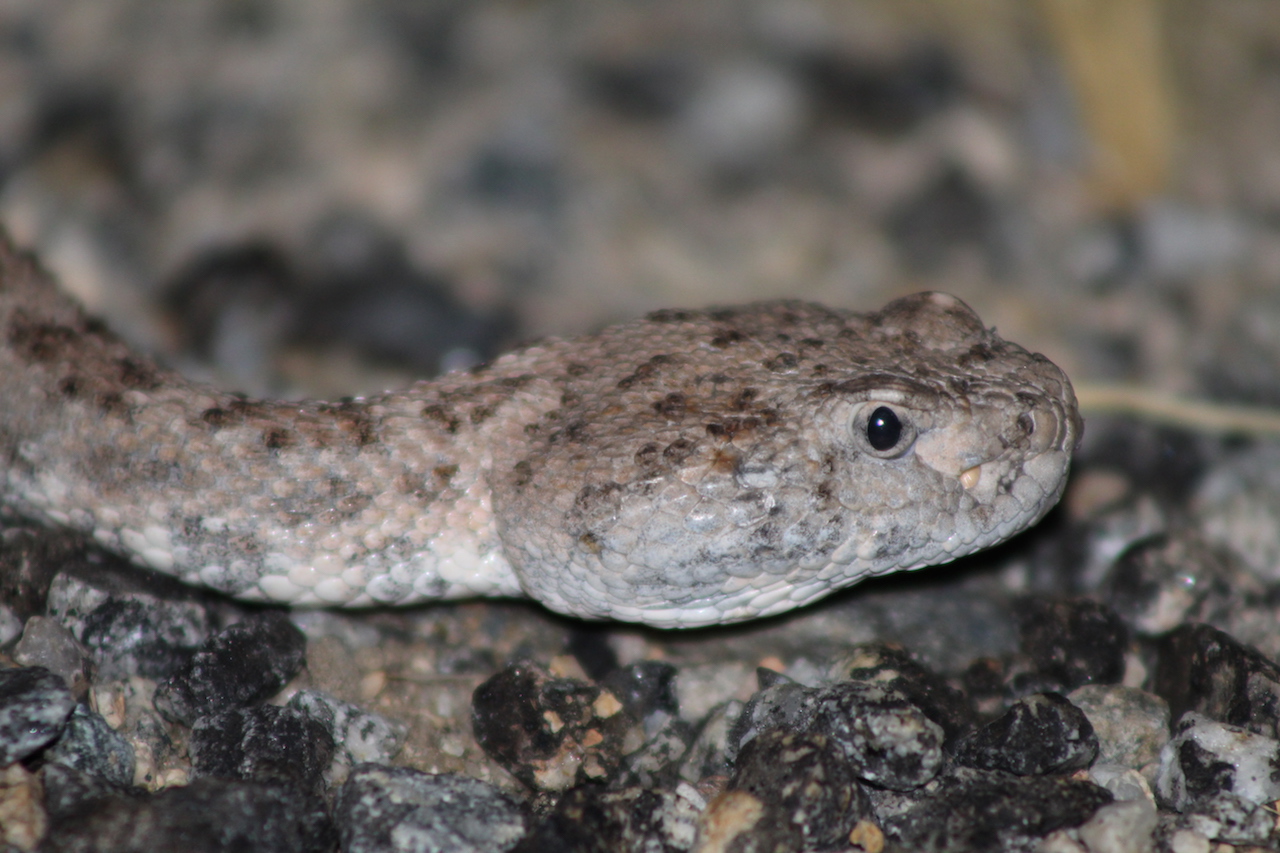
It slithered right by us and off the road and continued its hunt as seen below. I apologize about the profanity.
There may be some more experimental videos later on. Just checking out some different media forms.
As the night continued, the luck kept coming. One more speckled before we left the park.
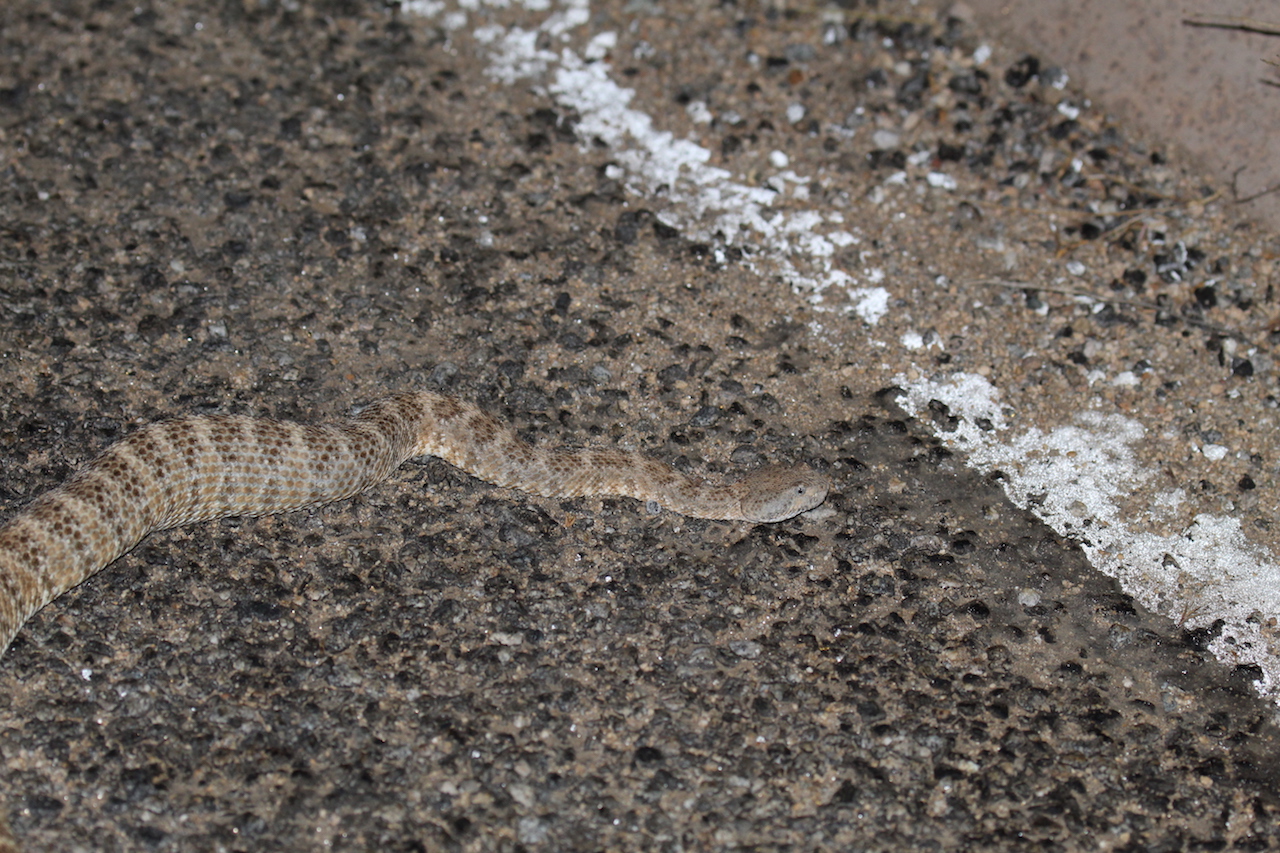
This one was smaller than the other two, but sported a little meal bump. I think its meal bump made it a little lethargic and more defensive. It is the only rattlesnake I have seen this trip that actually coiled up into a defensive position and rattled.
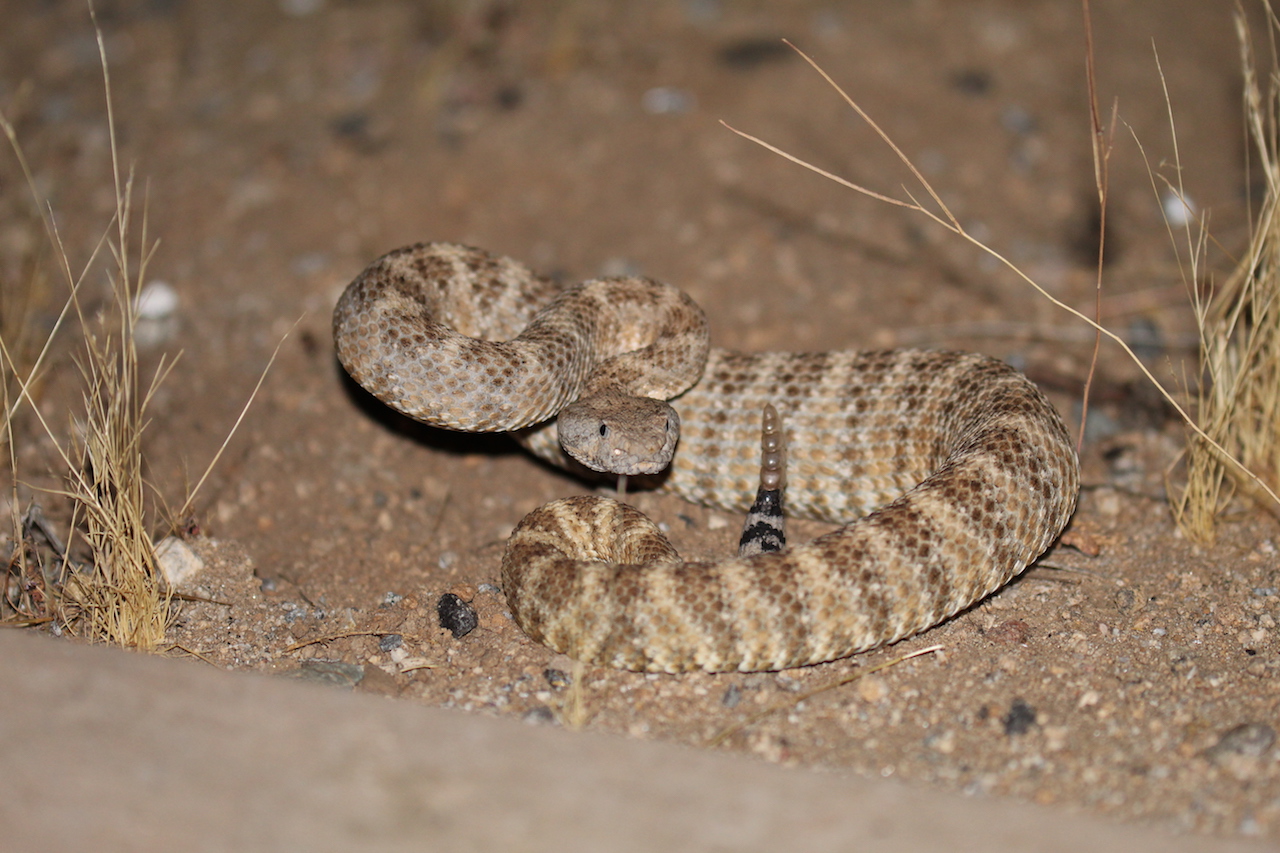
Huge day! I expected the search for the Speckled Rattlesnake to take much longer so rounding this hump is monumental. I’ll be looking for the Western Diamondback over the next couple days and seeing if I can maybe come up on another variant of a Speckled.
August 20
After taking the night of the 19th off in order to catch up on rest, I was ready to get back at it. Having already found the other two rattlesnakes, my attention has turned to the Western Diamond-backed Rattlesnake. I sent a new location and as the trend seems to be when herping in unknown areas I had very little luck. I spent most of the night wandering around a park that didn’t look promising and watched thunderstorms approach. Thankfully, as I was leaving the park I stumbled upon a desert nightsnake making the night not a total bust.
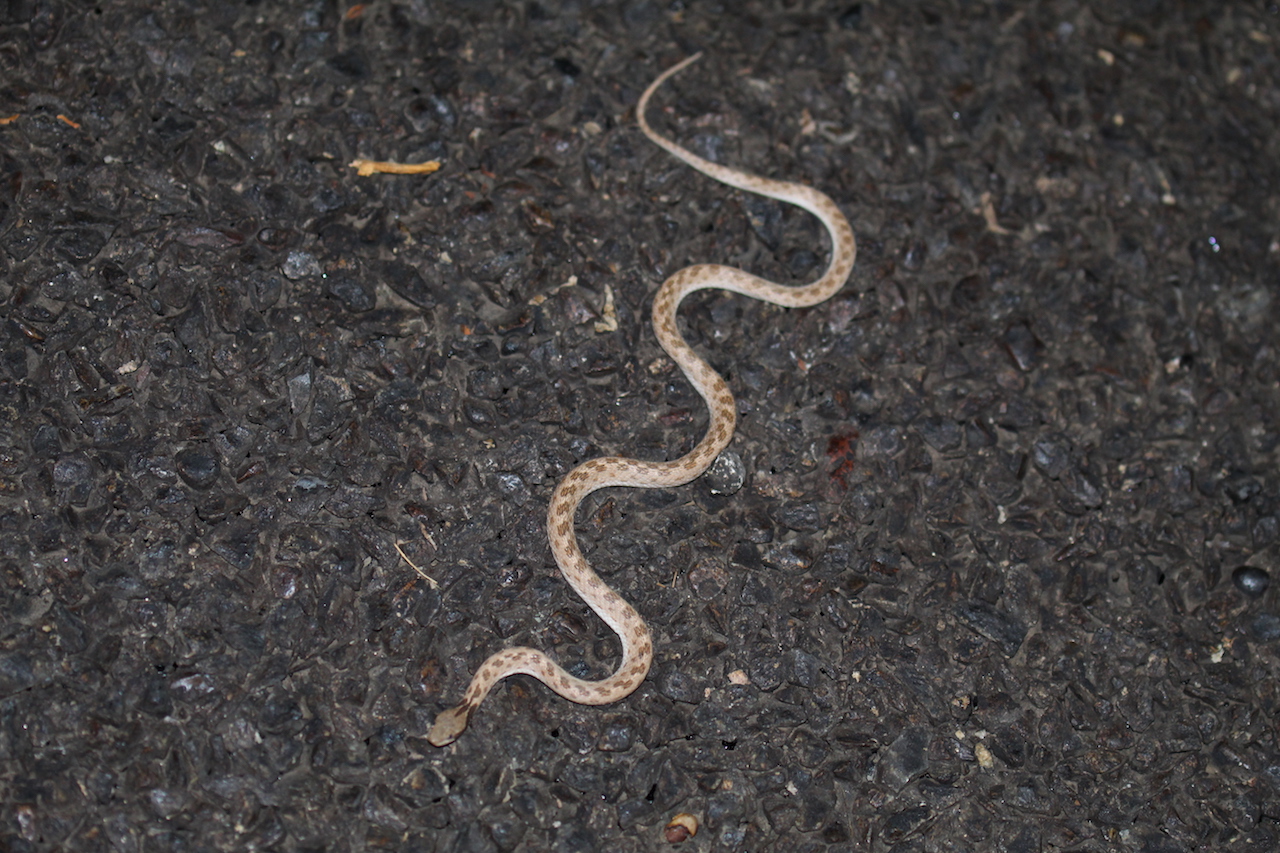
Rough night, walked that little guy in circles trying to get a good picture. The one I got was over exposed and out of focus. Either way just happy not to get skunked on the night and get out of there before the thunderstorm made it. On the way back to the hotel I saw a DOR sonoran gophersnake.
August 21
On the final herping night of the trip, I had high hopes. Changed up the locations I was searching for the diamondback, picked some roads, and headed out. Nearly two hours from the hotel I was staying at, the night started off great. At the start of the first couple roads I came upon a neonate diamondback. Seems like there is a trend of my lifers being neonates.
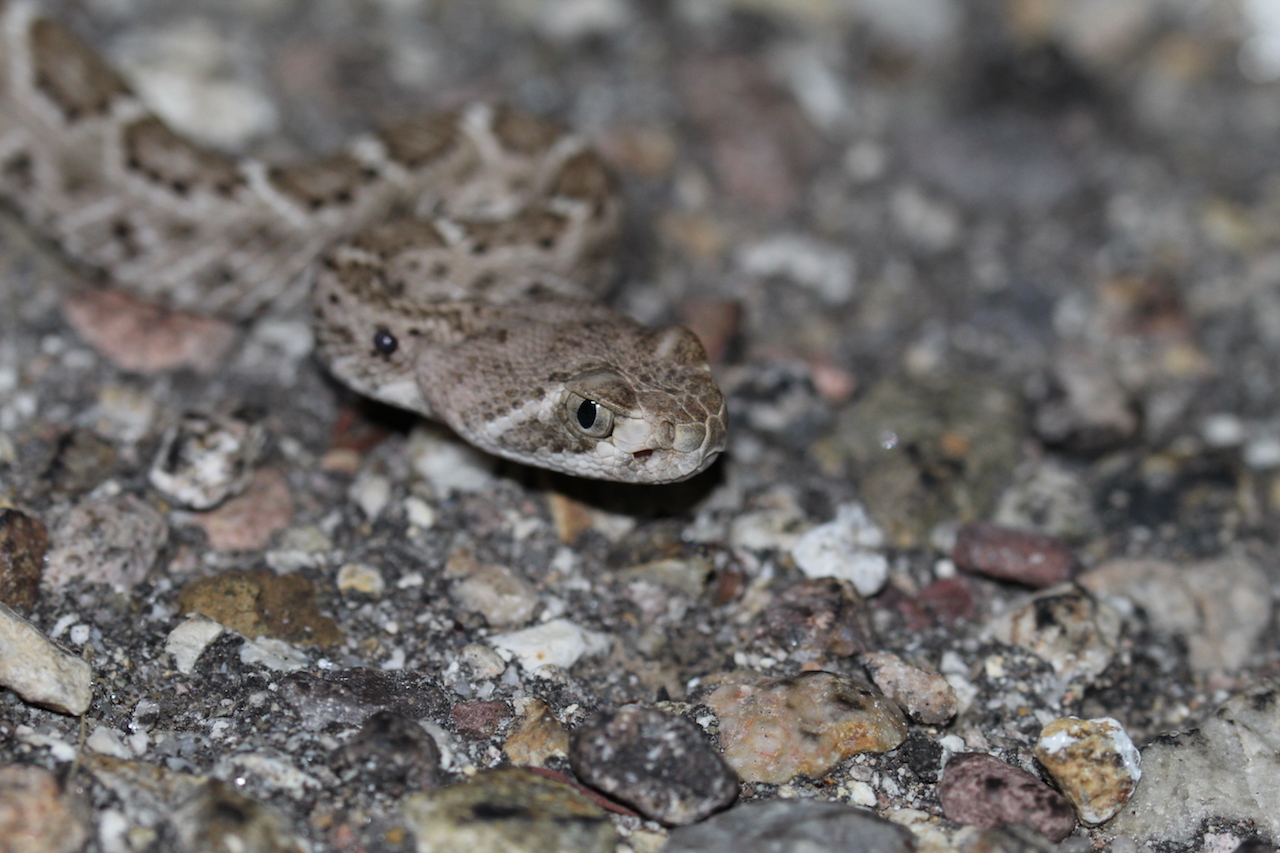
As this was my lifer and a target of the trip, I took a handful of shots to properly ID the snake. It seemed as though the greatest possibility at misidentification was confusion with the Mohave Rattlesnake (due to the lack of overlap with the Red Diamond-backed Rattlesnake I was not worried about that). From the shot above, you can see the eye stripe does not extend as far back as it does on the Mohave.

More than the two supraocular scales present on the Mohave.
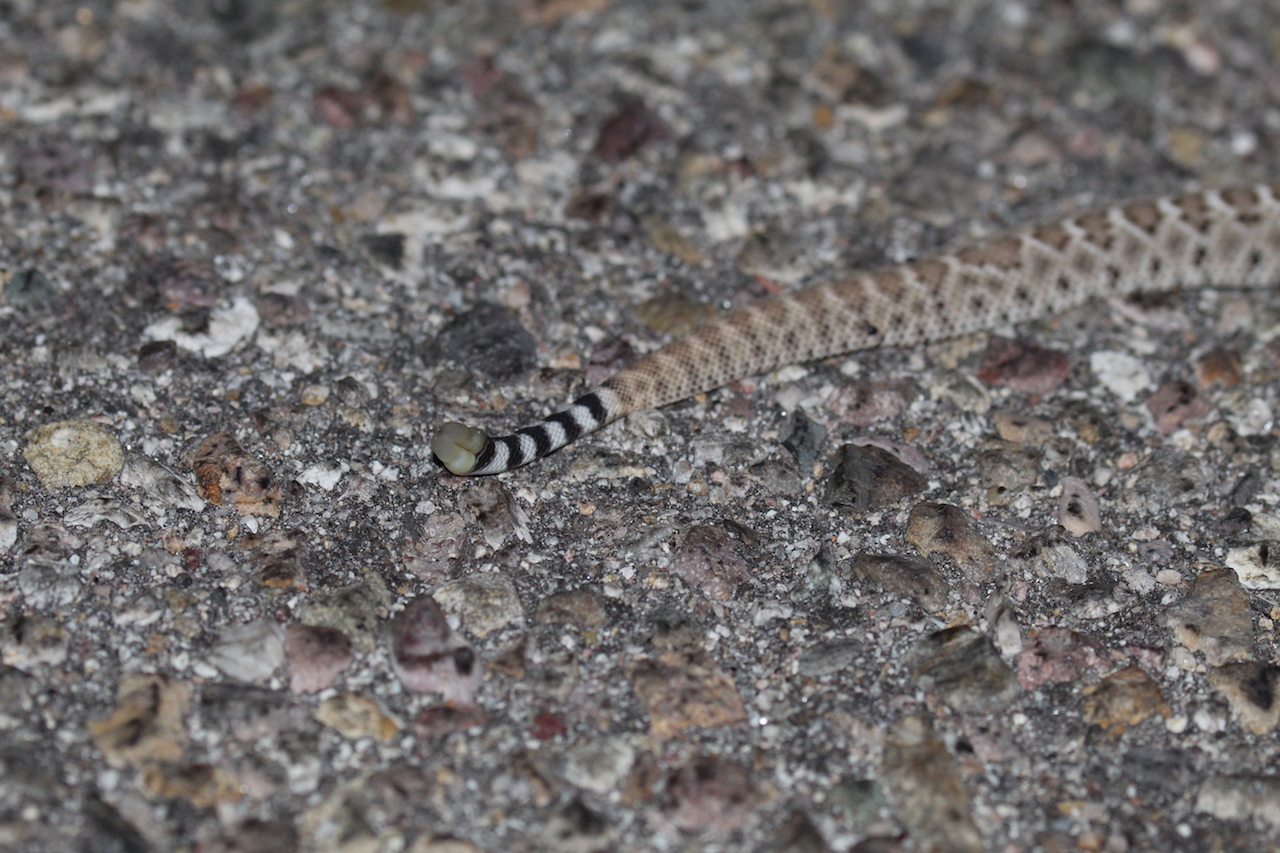
Closest band to the rattle is black and the bands are fairly equal in width. Pretty confident in the identification that this neonate is a Western Diamond-backed Rattlesnake. With that, I have successfully hit all my targets for the trip! That being said, the night was still young so I continued with my roads. Had little success for the next three hours and all of the places I wanted to hike were closed at sundown. After exhausting my preparation, I decided to cruise the road that I found the diamondback on again. I noticed a trail head that I hadn’t before and saw it wasn’t closed at night. Parked, pulled out my plethora of flashlights, and began the hike. Quickly came to a wash and decided to explore it. Within a matter of minutes I saw another diamondback, this one just chilling next to a hole.
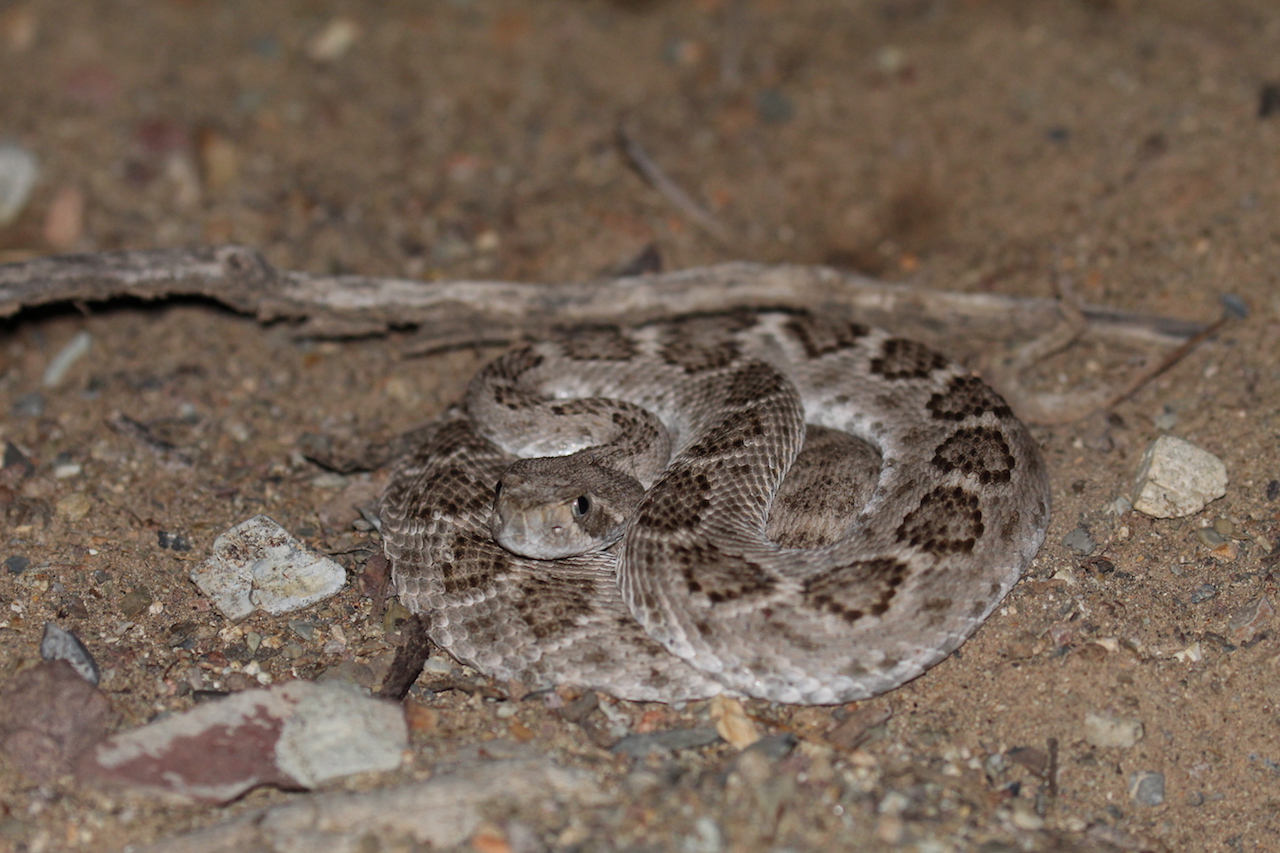
Didn’t want to bother it too much. Snapped a quick picture and moved along with renewed vigor. Further down the wash, the rock walls built a little on either side created some holes and crevices. Wasn’t long before more snakes were spotted. Great spot from my brother who was enthusiastically checking crevices. His attention to detail paid off with this spot of double diamondbacks in one hole.
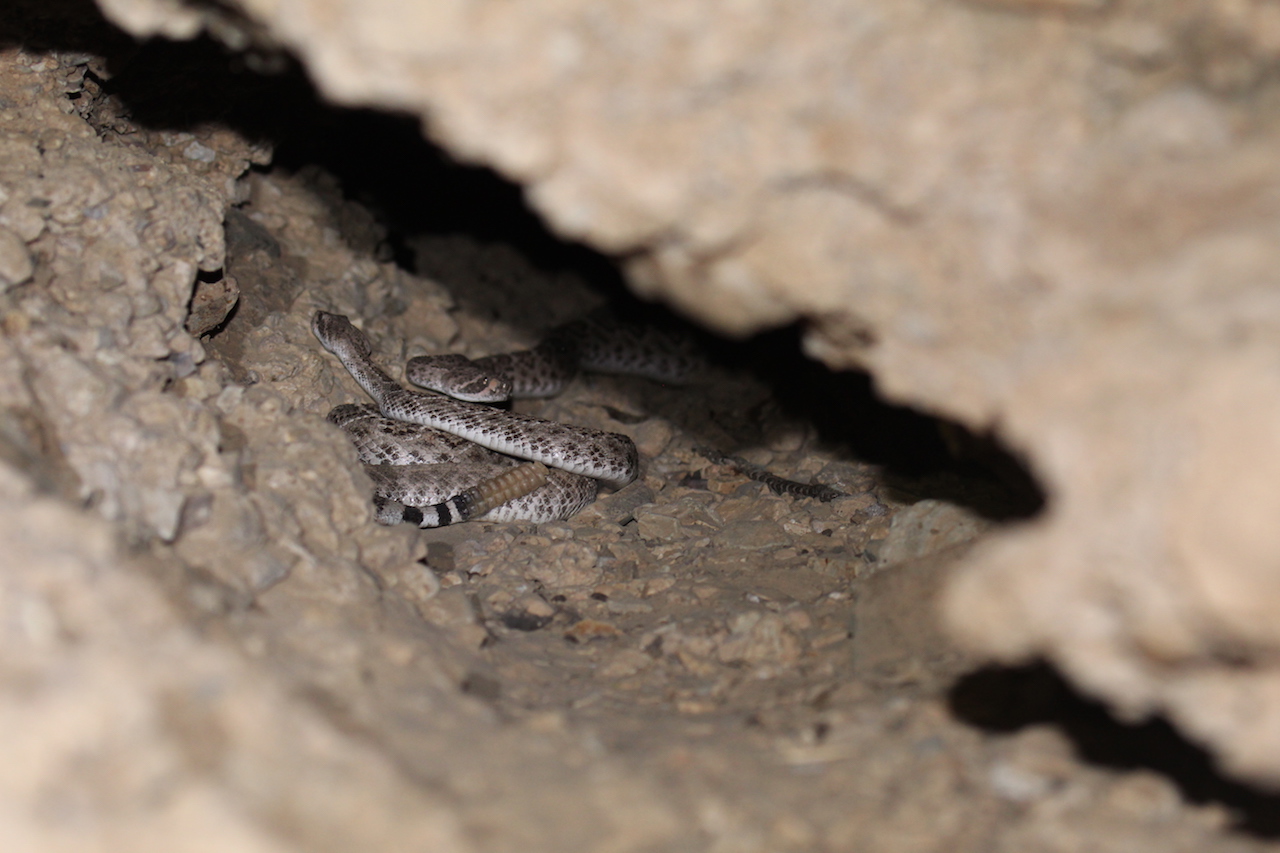
I’m fairly certain it is too late for them to be a mating pair. Were they both just finding shelter in the same location?
The next snake spotted returned to the normalcy of one snake at a time. This was a beefy diamondback which seemed to be resting on a ledge. Wish I could have gotten above it as the diamondback pattern seemed to be quite clean.
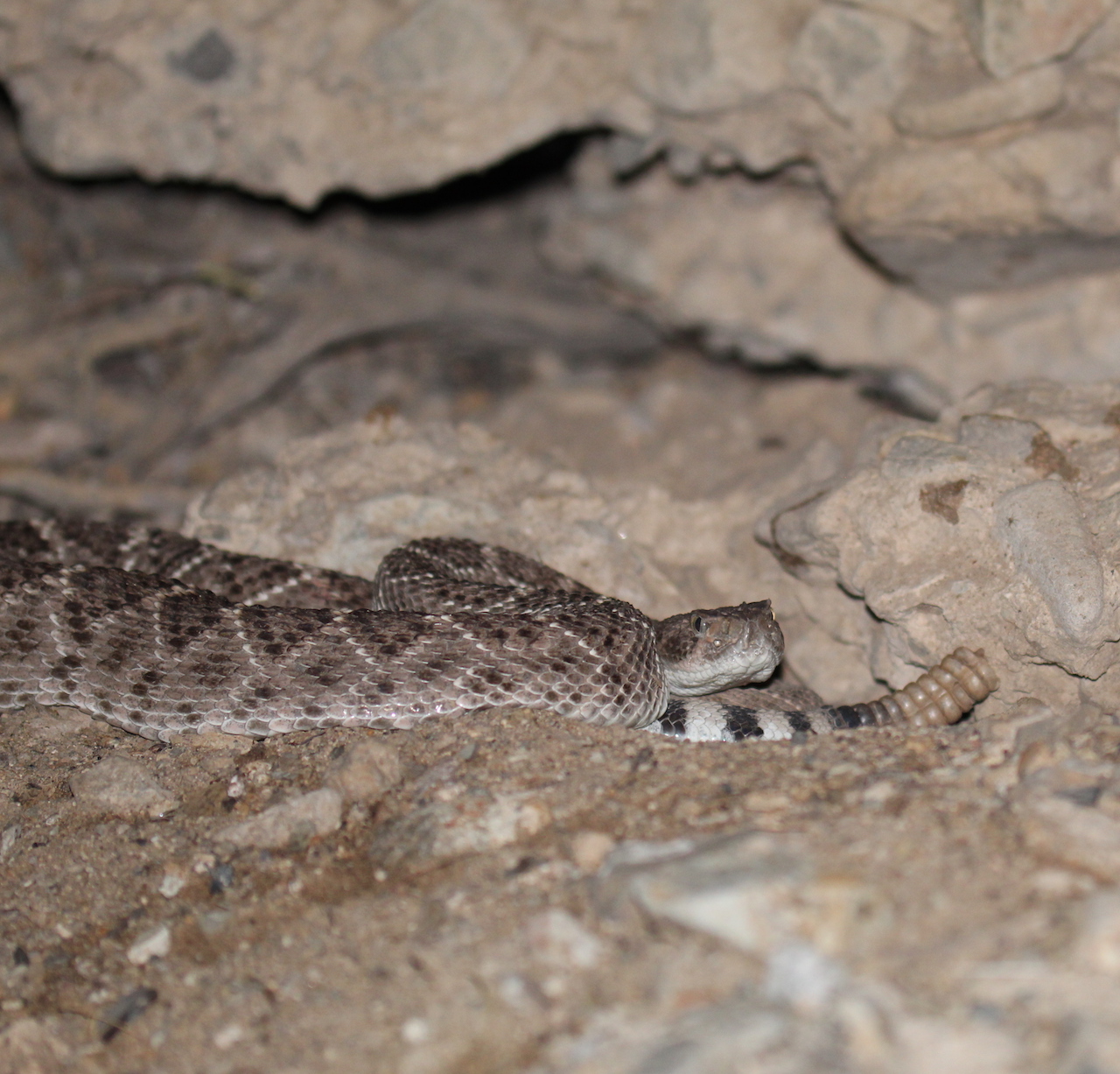
As it was getting late we decided to head back. As we were about to leave the wash we heard a sound and turned off our lights for a moment to see if we could hear it again. Next thing I knew, I heard something moving between my brother and I. I don’t know who was startled more. Once everyone was aware of each others presence, the diamondback coiled up and my brother and I backed up before taking out the camera. We will never know if I walked past the snake or it slithered between us when we paused to listen. Either way, this goes to prove the defensive nature of snakes. It wasn’t until we put a light on it that it coiled up, it had been content with us passing by. Good thing we didn’t step on it as it was bigger than the snake we had just seen.
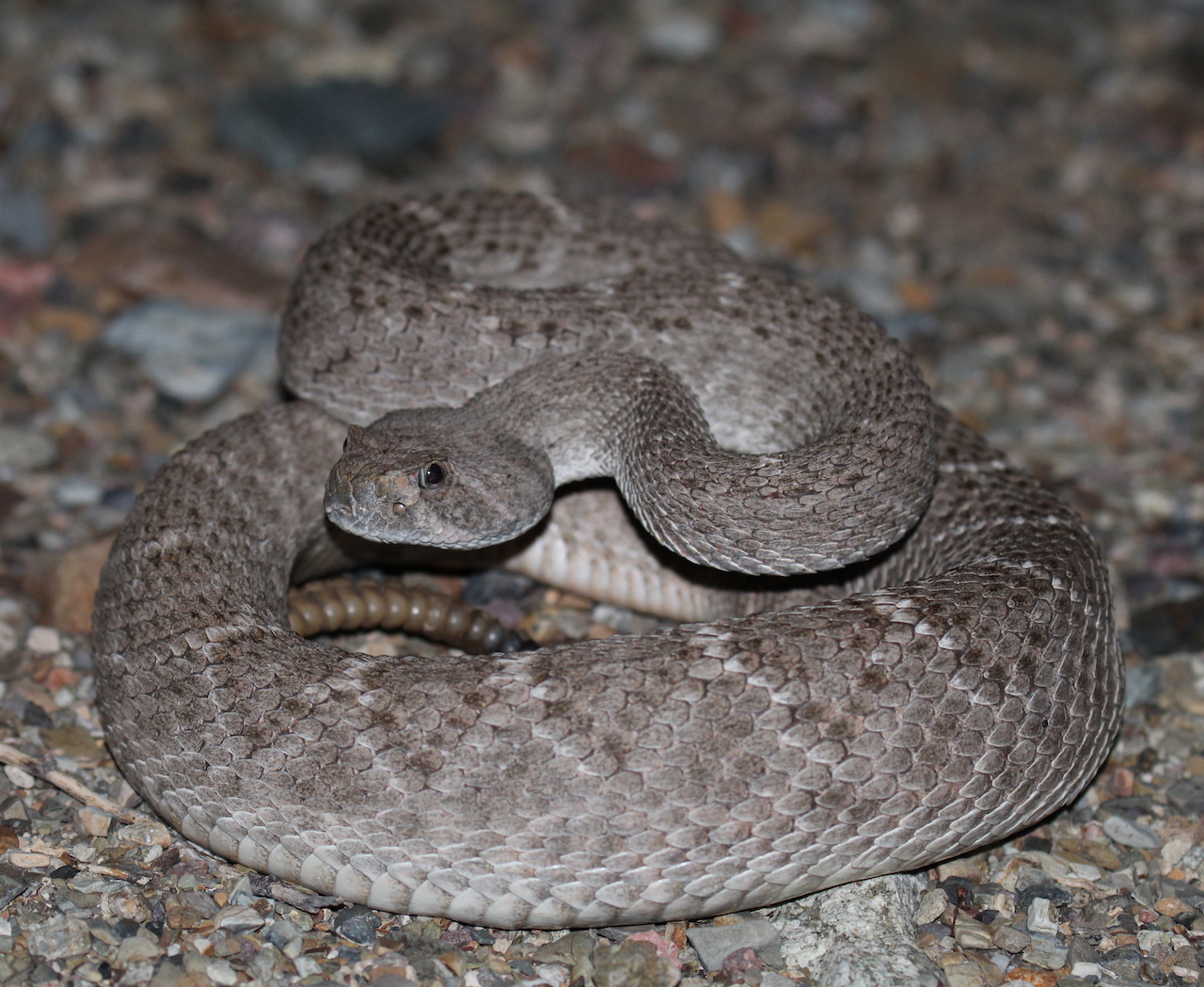
After that incident we were ready to get out of there and were extra cautious on the way back to the car. So cautious that we saw a nightsnake slithering across our path.
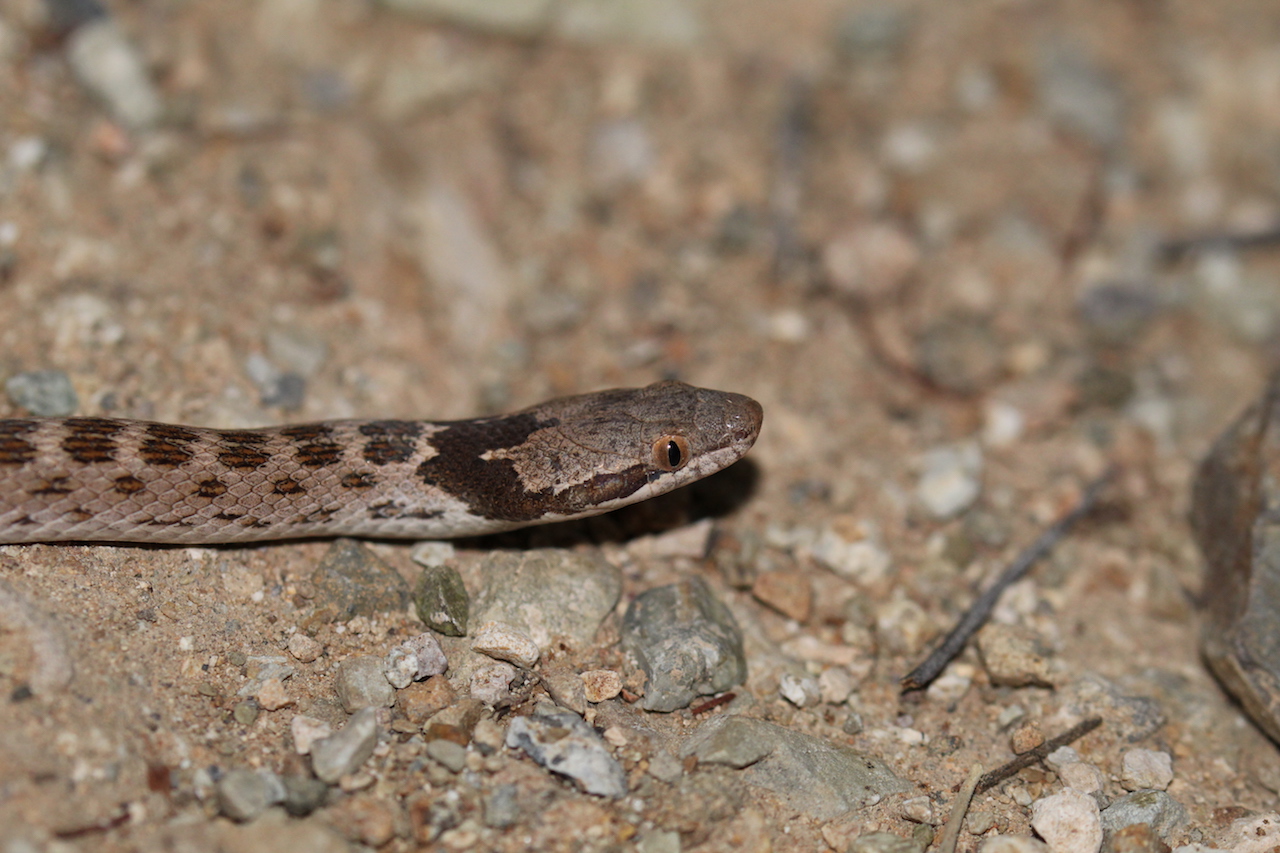
Quite the eventful night. With the exception of a DOR long-nosed snake, that marks the end of our successful trip.
Trip Conclusion
This trip was incredibly successful with the finding of all three of the targeted species. There is an extra sense of accomplishment as two of the species were successfully hiked up indicating an understanding of their habitat and ideal conditions. In total 17 snakes of 7 species were found over the five nights of herping: 6 Western Diamond-backed Snakes, 3 Southwestern Speckled Rattlesnakes, 2 Mohave Rattlesnakes, 2 Colorado Desert Sidewinders, 2 Desert Nightsnakes, a long-nosed snake, and a california kingsnake. Four lifers is exciting and just goes to show how little time I have spent in Southern California.
Summer Conclusion
I know this post is massive, but as this is my last trip of the summer I am going to wrap up the summer herping here rather than in a new post. This was a great summer primarily defined by my early arrival home, the flourishing of my boards, and the trips down south. The early arrival home led to a lifer that was overdue, the Pacific Ring-necked Snake. The boards led to a couple crazy days of 20+ snakes. It became the summer of rattlesnake species as I explored southern california and found all the rattlesnakes it had to offer. The goal of next summer seems to be finishing off the california rattlesnakes (Great Basin Rattlesnake), search for the elusive California Mountain Kingsnake, and try to knock out some more lifers such as the Rosy Boa, Alameda Whipsnake, and maybe even the San Francisco Gartersnake.
This summer in numbers:
156 snakes, 22 total species, 16 lifers
Three most found snakes: California Kingsnake (46), Pacific Gophersnake (44), and the Pacific Ring-necked snake (12) making up 102 of the 156 snakes or 65% of the total snakes seen. No other snake had double digit encounters.
27 rattlesnake encounters with 8 species, only missing the Southern Pacific Rattlesnake (seen last year) and the Great Basin Rattlesnake.
3 snakes found wandering my neighborhood; a california kingsnake, pacific gophersnake, and common sharp-tailed snake.
I would say the most exciting snake found was the Southwestern Speckled Rattlesnake.
With that, see you on the next herping adventure whenever that may be.